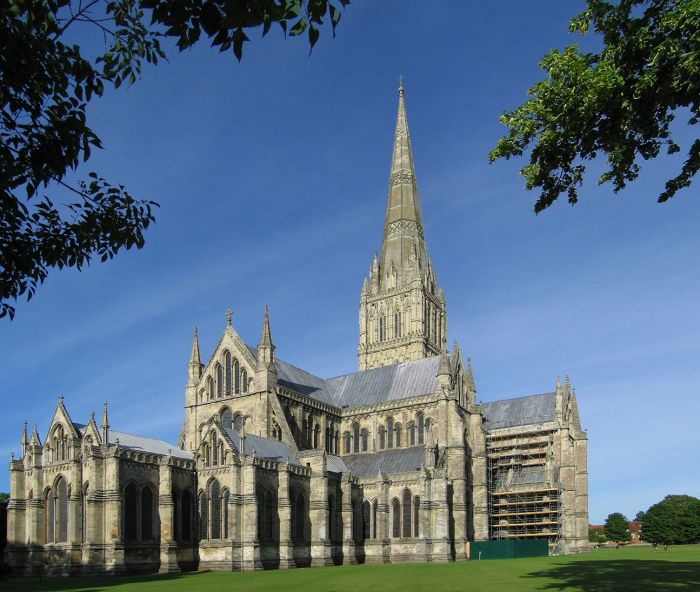|
Từ điển Oxford Advanced Learner 8th
 cathedral
cathedral

cath·edral [cathedral cathedrals] BrE [kəˈθiːdrəl] NAmE [kəˈθiːdrəl] noun
the main church of a district, under the care of a ↑bishop (= a priest of high rank)
•St Paul's Cathedral
• (BrE)a cathedral city
Word Origin:
Middle English (as an adjective, the noun being short for cathedral church, ‘the church which contains the bishop's throne’): from late Latin cathedralis, from Latin cathedra ‘seat’, from Greek kathedra.
Culture:
churches and cathedrals
In Britain churches are landmarks in every town and village. Their tower or spire (= a cone-shaped structure on top of a small tower) can often be seen from far away. Churches are used for worship by the ↑Church of England, ↑Roman Catholics and other groups, while some Nonconformist Churches use chapels or halls. The church and church hall, a building used for meetings and Sunday School, were formerly the centre of the community. Now, far fewer people attend church and this has resulted in some churches being closed or used for other purposes such as housing.
Cathedrals may belong to either the Church of England or the Roman Catholic Church. Many cathedrals were built as part of a monastery, for example ↑Durham was started in the 11th century by Benedictine monks. Some of these cathedrals are called minsters, e.g. ↑York Minster, and they were originally centres for teaching Christianity. St Chad’s in Birmingham dates from the middle of the 19th century and was the first Roman Catholic cathedral built in England since the Reformation. A cathedral is the headquarters of a ↑bishop or ↑archbishop. Canterbury Cathedral is the headquarters of the ↑Archbishop of Canterbury, who is head of the Church of England.
Many people visit churches and cathedrals to admire their architecture. In Britain churches are usually built of stone, with a tower or spire at the west end. Bells are placed high up in the tower and rung by long ropes before services. In villages the church is approached through a gate, sometimes a lychgate (= a gate with a roof over it), which leads into the churchyard where people are buried. The main entrance is usually on the south side. The church porch has a noticeboard and often a seat in it. Cathedrals are large churches, usually built in the shape of a long cross with a central tower. Older cathedrals are often in a quiet grassy cathedral close.
The earliest stone churches date from the ↑Anglo-Saxon period (6th-11th centuries). ↑Norman churches, from the 11th and 12th centuries, are massive structures. Rounded arches over doorways and windows are a distinctive feature of Norman architecture. Examples of Norman cathedrals are those at Durham and Ely.
The English ↑Gothic style of the 13th-15th centuries is characterized by pointed arches and increasingly ornate designs for the vault. Windows were tall and narrow in the ↑Early English period (13th century), and later, in the Decorated period, had tracery (= lace-like patterns) at the top. In the Perpendicular period (15th century), they were greatly increased in size and filled with stained glass (= small pieces of coloured glass in a lead frame) showing pictures of saints. Ceilings with elaborate fan vaults (= curved strips of stone spreading out from a point, with patterns between them) are supported by flying buttresses that lean at an angle from the wall and form an arch. Salisbury Cathedral is a characteristic Early English building. Exeter Cathedral dates mainly from the Decorated period and Gloucester Cathedral with its fan vaults is typical of the Perpendicular period.
Some later buildings, such as ↑St Paul's Cathedral designed by Christopher Wren, are more like classical temples, with a central dome and spire added. Wren and James Gibbs, designer of ↑St Martin-in-the-Fields, influenced architects in America: Christ Church in ↑Philadelphia is a copy of St Martin. But the modern Coventry Cathedral, designed by Basil Spence in the 1950s, is a hall-like church with narrow stained-glass windows.
In the US the earliest churches were one-room buildings made of wood that were used also as schools. Most communities now have several churches in varying styles. Some are made of stone in order to look like old English churches, some are small, plain buildings made of brick or wood, and others are modern buildings with glass walls. Storefront churches are found in shopping streets and look like shops/stores.
Example Bank:
•The great Gothic cathedral dominates the city.
•We went to mass in the cathedral.
•St Paul's Cathedral
|
|
|
|
